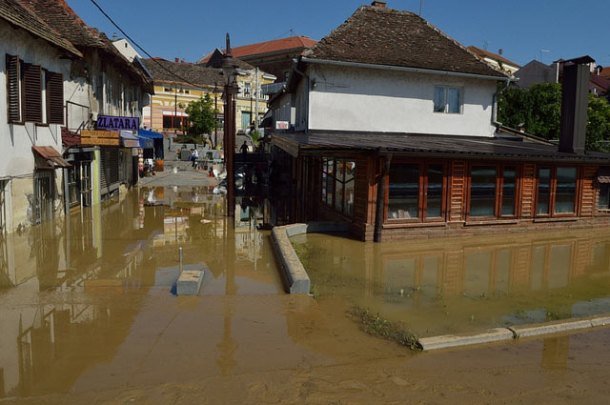The recent floods in Bosnia underscore the urgent need to ramp up demining efforts in the region.
In the past few days, I’ve received numerous inquiries from both journalists and friends regarding the potential displacement of landmines by the recent floods in Bosnia.
This aspect often catches people off guard, possibly because their perception of a minefield is influenced by the computer game Minesweeper, where a mine remains stationary until it’s cleared.
However, in reality, landmines are situated within a dynamic environment. When buried, they can move due to soil shifting during seasonal freezes and thaws. Additionally, soil erosion can uncover mines, while floods, such as those currently affecting the Balkans, can potentially displace mines and carry them to different locations.
The issue of landmines in Bosnia traces back to the conflict in the early 1990s. Despite significant clearance efforts since then, approximately 1,219 square kilometers of land are still suspected to be contaminated by mines, impacting 1,417 communities and 540,000 individuals. This year alone, there have been six landmine accidents resulting in four fatalities and eight injuries.
In 2012, the Bosnian government reported about 120,000 landmines remaining in the ground. By 2013, only 1,800 had been removed. However, accurately estimating the number of mines in a minefield is exceedingly challenging – akin to estimating the number of stones in a sealed jar.
Also Read On: What Happened To Barnaby Joyce Face? Footpath Video Viral
Mines are typically not laid out in uniform patterns, and records on their placement are often inadequate or misplaced.
The precise boundaries of a minefield are often uncertain, yet de-miners utilize a “general and technical survey” process to delineate the “suspected hazard area.”
The Mine Ban Treaty and international regulations for mine clearance mandate that countries affected by mines, such as Bosnia, demarcate contaminated zones adjacent to inhabited areas with fences and signage.
However, minefields are dynamic, and flooding can relocate mines to areas previously deemed safe by residents and authorities.
If you wish to learn more about the impact of the floods on the mine situation in Bosnia, reach out to the humanitarian de-mining experts operating in the region. For instance, you can find updates on the Bosnia and Herzegovina Mine Action Center (BHMAC) website.
Acknowledging that mine clearance isn’t solely a technical challenge is important. Concerns about the potential movement of Bosnia’s minefields wouldn’t arise if there weren’t mines present initially. The ongoing presence of these mines reflects the slow pace of de-mining efforts.
Upon joining the Mine Ban Treaty in 1999, Bosnia committed to clearing all mined areas by 2009. However, in 2008, it requested and received a 10-year extension, pushing the deadline to 2019. Despite this extension, there is consensus among de-mining experts and officials in Bosnia that they will not meet the revised deadline.
Why is there such reluctance? The mine issue in Bosnia is plagued by political inertia. The parliament has failed to enact a new de-mining law and consistently allocated insufficient funds for mine clearance, providing less than a third of the planned budget for 2013 alone.
Moreover, the government agency tasked with overseeing de-mining has been embroiled in a purported political scandal. Interest from foreign donors, including governments, is also dwindling rapidly. Furthermore, international funding often comes in the form of small, short-term projects, hindering long-term planning and optimal resource utilization.
Bosnia has directed its available funds towards land surveying, particularly in areas with no credible evidence of contamination initially. Consequently, the clearance of areas confirmed to contain anti-personnel mines, which significantly impact community safety, has been delayed.
For instance, in 2013, Bosnia only cleared a mere 1.9km2 of land through direct mine detection and destruction, while 33km2 was released through non-technical survey methods, which do not involve entering mined areas. The combined area released through clearance, technical, and non-technical surveys in 2013 amounted to 44.3 km2, less than one-third of the planned total.
The recent flooding in Bosnia has underscored the vulnerabilities in the country’s de-mining infrastructure and the support it receives from the international community.
In addition to addressing the immediate crisis, Bosnian authorities must rebuild public trust in the mine clearance process by enacting new de-mining legislation, ensuring sufficient funding for their strategy, and prioritizing the clearance of confirmed mined areas, particularly those posing the greatest risks to communities.
Foreign donors must also increase their efforts to help Bosnia meet its goal of completing clearance by 2019.
This article was originally published on the Landmine and Cluster Munition Blog.
 Dr. Matthew Bolton is author of Foreign Aid and Landmine Clearance: Governance, Politics and Security in Afghanistan, Bosnia and Sudan and Assistant Professor of Political Science at Pace University, and Landmine Monitor Researcher.
Dr. Matthew Bolton is author of Foreign Aid and Landmine Clearance: Governance, Politics and Security in Afghanistan, Bosnia and Sudan and Assistant Professor of Political Science at Pace University, and Landmine Monitor Researcher.
Image of recent flooding in Bosnia courtesy of Ian Bancroft.
Also Read : Nayib Bukele Family: Wife Gabriela Rodríguez de Bukele And Kids


